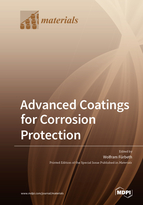Advanced Coatings for Corrosion Protection
A special issue of Materials (ISSN 1996-1944). This special issue belongs to the section "Corrosion".
Deadline for manuscript submissions: closed (31 May 2020) | Viewed by 50263
Special Issue Editor
Interests: corrosion; corrosion protection; corrosion testing; coatings; nanocoatings; sol-gel coatings; self-healing; anodising; plasma-electrolytic oxidation; electrochemical corrosion investigations; scanning Kelvin probe; electrochemical impedance spectroscopy
Special Issues, Collections and Topics in MDPI journals
Special Issue Information
Dear Colleagues,
Corrosion is an important issue in many industrial fields. It leads to high economic losses of 3–4% of the GDP of an industrialized country year by year. Adequate corrosion protection is therefore essential in many applications. Among others, coatings are by far the most important technology for the corrosion protection of metallic surfaces.
In recent years, the very traditional field of coatings for corrosion protection has gained a deeper understanding of the mechanisms of protective action and corrosion mechanisms of and under protective coatings. This was necessary due to emerging environmental and health issues for some well-established compounds used in former coating systems, e.g., lead or chromates, that have been banned from industrial application. This has also led to a large amount of research in the field of advanced coating systems for corrosion protection.
This situation is the case for all the different types of protective coatings that are typically used. Novel metallic coatings, e.g., novel zinc alloys, are under development as well as novel pretreatment systems or passivating chemicals that avoid the use of chromates. The rise chemical nanotechnology has fostered the development of hybrid or inorganic sol-gel coatings, as well as nanoparticles and nanocapsules to be used as fillers in coating systems. This has also led to the development of novel self-healing and smart coatings. Furthermore, today, bio-based substances are increasingly used for organic coatings. Last but not least, new anodizing processes have also been developed in the frame of increased use of light metals for lightweight construction.
It is my pleasure to invite you to submit a manuscript on any of these types of advanced coatings for corrosion protection for this Special Issue. Full papers, communications, and reviews are all welcome.
Prof. Wolfram Fürbeth
Guest Editor
Manuscript Submission Information
Manuscripts should be submitted online at www.mdpi.com by registering and logging in to this website. Once you are registered, click here to go to the submission form. Manuscripts can be submitted until the deadline. All submissions that pass pre-check are peer-reviewed. Accepted papers will be published continuously in the journal (as soon as accepted) and will be listed together on the special issue website. Research articles, review articles as well as short communications are invited. For planned papers, a title and short abstract (about 100 words) can be sent to the Editorial Office for announcement on this website.
Submitted manuscripts should not have been published previously, nor be under consideration for publication elsewhere (except conference proceedings papers). All manuscripts are thoroughly refereed through a single-blind peer-review process. A guide for authors and other relevant information for submission of manuscripts is available on the Instructions for Authors page. Materials is an international peer-reviewed open access semimonthly journal published by MDPI.
Please visit the Instructions for Authors page before submitting a manuscript. The Article Processing Charge (APC) for publication in this open access journal is 2600 CHF (Swiss Francs). Submitted papers should be well formatted and use good English. Authors may use MDPI's English editing service prior to publication or during author revisions.
Keywords
- metallic coatings
- anodizing layers
- sol-gel coatings
- pretreatments
- organic coatings
- self-healing coatings
- bio-based coatings







